What is the blue zone diet and does the science back it up?
Itâs the food movement everyoneâs talking about â but what does it involve and is it healthy?
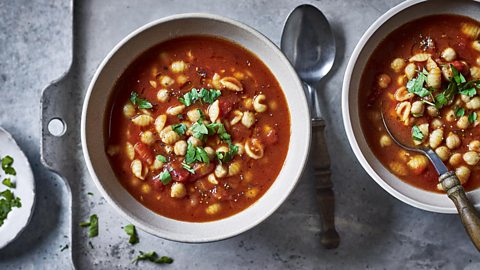
The blue zone diet is growing in popularity, with hashtags for it accruing over 14 million views on TikTok alone. There is even a new documentary series highlighting its potential health benefits.
Despite the heightened media interest surrounding the diet, it can be hard to decipher the facts and work out if itâs a good choice for you. As a dietician, I decided to investigate.
What is the blue zone?
The term âblue zoneâ is non-scientific but is used to describe areas of the world where people are most likely to live to the age of 100 or more. In fact, says people in these areas âreach age 100 at 10 times greater rates than in the United Statesâ.
It was popularised by Dan Buettner, an American author and National Geographic journalist.
The five blue zone locations he pinpointed are:
- Ikaria, Greece
- Loma Linda, California
- Nicoya Peninsula, Costa Rica
- Okinawa, Japan
- Sardinia, Italy
It has been suggested that people in these five regions have lower levels of chronic health conditions like diabetes, heart disease and cancer. Buettner found certain common threads between them which, he says, explains why inhabitants are more likely to have good health and live longer.
One of the main commonalities is , although other lifestyle factors also play a role â more on those later.
What does the blue zone diet involve?
The blue zone diet is mainly plant-based, but itâs important to note that common diets in the five regions due to cultural, historical, religious and social traditions, as well as the availability and production of foods in the different areas. That said, there are a few themes running throughout that form the backbone of the diet.
Fruit and vegetables
People in the blue zones tend to eat plenty of fruits and vegetables like squash, peas, lettuce, spring onions and papaya. These ingredients provide essential vitamins, minerals, dietary fibre and phytochemicals (), which are beneficial for overall health.
Thereâs a lot of showing that higher intakes of fruit and vegetables are linked to lower mortality caused by chronic conditions like heart disease and cancer. (Thatâs as well as plenty of research suggesting a variety of positive impacts on general health too, from to digestion.)
Ratatouille
Featuring lots of vegetables in a rich tomato sauce, this is a great way to get your five-a-day

In the UK, the we should have at least five portions (400g) of different fruit and vegetables every day, with fresh, canned and frozen varieties all contributing towards our intake.
Beans and pulses
These healthy plant-based proteins are the cornerstone of every blue zone diet. Offering great nutritional benefits, they are high in dietary fibre and low in saturated fat, and have even been suggested to have , which can positively influence healthy aging.
Chickpea traybake pittas
With roasted chickpeas, plenty of veg and wholemeal pittas, this dish combines several blue zone diet components
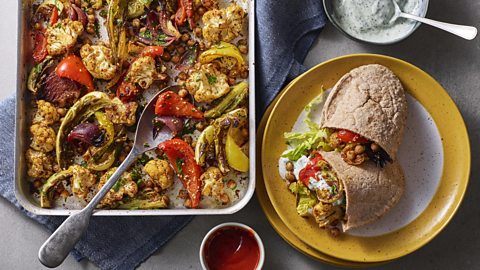
Black beans are staples in Nicoyan meals, while chickpeas, lentils, garbanzo and white beans are popular in Ikaria and Sardinia, and soybeans are mainstays of an Okinawan diet.
Wholegrains
Most blue zone residents consume a lot of wholegrains. These are typically low in fat but high in dietary fibre and can provide essential fatty acids, B vitamins, folic acid and other beneficial micronutrients. Wholegrains include oats, barley, brown rice and ground corn.
A diet rich in wholegrains is linked with a reduced risk of chronic diseases, including .
With brown rice and lots of veg, this is a nourishing dish
Healthy fats
Residents of these five specific regions are more likely to reach for unsaturated fats (think olive oil, avocados and fatty fish like mackerel) than saturated ones (fatty meat, cream, butter and cheese), which we know can help .
Smoked mackerel, radish, cucumber, dill and bulgur wheat grain bowl
With plenty of omega-3, mackerel is regarded as a healthy fat
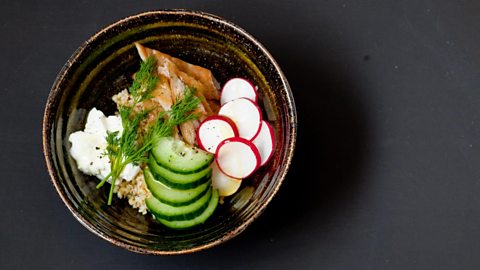
Also, most of the blue zone diets involve consuming a handful of nuts like almonds, walnuts and pistachios (which can also be a source of unsaturated fat) each day. When combined with a healthy diet, this is linked to various , including protecting the heart.
Fermented foods
Fermented foods can contain probiotics â live bacteria and yeasts that are thought to have health benefits, including .
Fermented foods are found in most blue zone diets. For instance, sourdough wheat bread is a staple in Sardinia and miso soup is common in the Okinawan diet. However, the role of fermented foods in promoting longevity of life and healthy ageing does require further research, with much still unknown.
Kimchi
Fermented veg, like kimchi, is linked to good health

Fish
The amount of fish consumed by residents in the blue zones varies due to environmental factors such as availability, but in most areas itâs said to be eaten around three times a week (in small portions). Fish contains a lower amount of saturated fat than red meat and is a good source of nutrients. Oily fish is particularly rich in omega-3 fatty acids, which are essential for brain and heart health.
There are various ways to cook salmon â here are three of our favourite methods
It is recommended in the UK that a healthy diet should include at least of fish a week, one of which being oily fish like salmon, sardines or trout (from sustainable sources, where possible).
Meat
Red meat is consumed less frequently and in small amounts in most blue zone areas. In the classic Sardinian diet, for example, meat is usually reserved for .
Thatâs not to say that all of the regions consume a minimal amount. In the Nicoya Peninsula, at least half of the oldest Nicoyans are said to eat three to five servings of â though that is still less than the amount we are reported to eat .
Warm chicken salad
This can be served warm or cold, perfect for a quick healthy supper
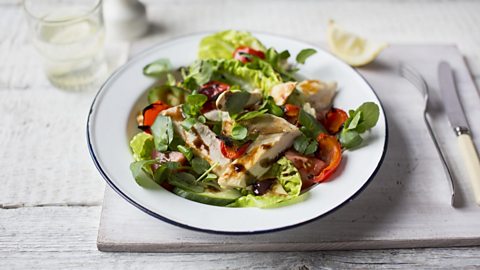
Although red meat like beef, lamb and pork can contribute towards a healthy diet (it is a good source of protein, vitamins and minerals), it should be consumed in moderation, especially when in processed forms like bacon, ham, sausages and salami. Eating less processed and red meat may lower the risk of .
Red wine
People in most blue zones drink between one and two glasses of red wine a day â but this is not a sign to start drinking if you donât drink now. There is an ongoing discussion about the potential health benefits of red wine due to its antioxidant properties, but it is not a necessity for a healthy diet and should only be consumed within safe limits.
The Department of Health recommends that if you are a regular drinker, you should not drink more than (a medium glass of red wine , and itâs also advised to spread the units evenly over three or more days. Itâs a good idea to have several drink-free days each week, too.
Water and tea
Drinking plenty of fluids â mostly water â is a hallmark of most groups living in the blue zone regions. Water is a healthy and cheap choice for staying hydrated, with some evidence suggesting that regular water intake may be linked to .
Other liquids such as tea can also contribute towards fluid intake, with green tea being a popular choice, especially in the Okinawa region.
Beyond the diet
When investigating why people in blue zones have longer (and healthier) lifespans, Buettner found there are lifestyle factors to be considered outside of diet, like . Itâs common for blue zone residents to incorporate plenty of movement into their day-to-day lives â think gardening, walking and doing physical chores.
They also prioritise rest and a good nightâs sleep: Ikarians take mid-afternoon naps, while the Loma Linda community âdownshiftâ (spend time resting) for 24 hours every week. Getting enough shut eye can be beneficial for lowering stress levels and maintaining good , as well as having positive impacts on physical health.
In addition, those in the blue zone regions have good social networks and are regularly eating with or surrounded by family, friends and neighbours. It is known that isolation and loneliness are contributors to , which reinforces the importance of fostering healthy communities and relationships.
Is the blue zone diet a good choice for you?
The diet is not a rigid, one-size-fits-all eating plan. Just incorporating certain aspects into your daily life, such as eating more vegetables, can be beneficial for general health.
The overall aim here, though, is to consume a wide variety of foods in the right proportions and in line with . This involves incorporating plenty of fruit and vegetables, wholegrains and proteins and a moderate amount of unsaturated fats into your diet, while keeping intake of free sugars, saturated fats and salt to a minimum.
Having said this, before a blue zone diet can be formally recommended.
Spiced vegetable tagine
This full-flavoured tagine is a cheap, healthy way of getting extra vegetables into your diet
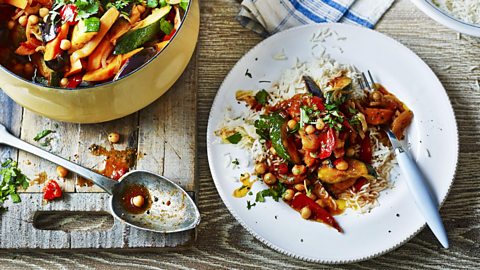
Some experts and influencers have suggested people should focus on a diet from a single blue zone region, but this could become restrictive and is not realistic for everyone to follow when considering that we all have different needs. Thatâs not to mention the fact that access to ingredients will differ depending on where you live and your budget constraints.
It is important to speak to a dietitian before making changes to your diet to ensure you are getting the right amount of nutrients your body needs to support your overall health and wellbeing.
Please note: Information is not intended as a substitute for proper medical diagnosis or dietary advice provided by your dietitian. Please always seek advice from a dietitian for tailored dietary advice and support.
Originally published November 2023